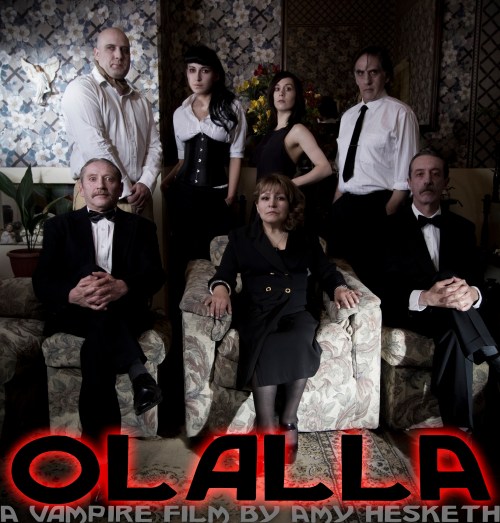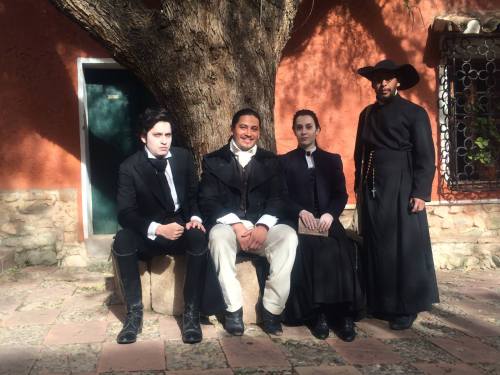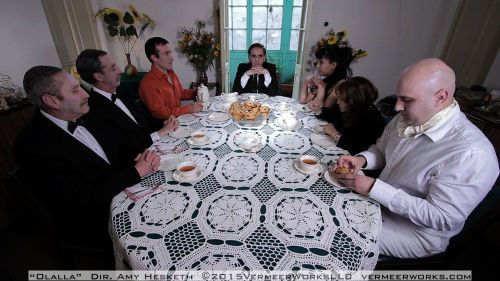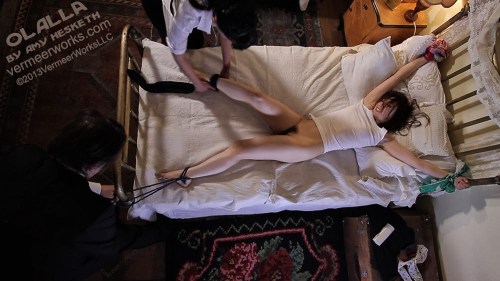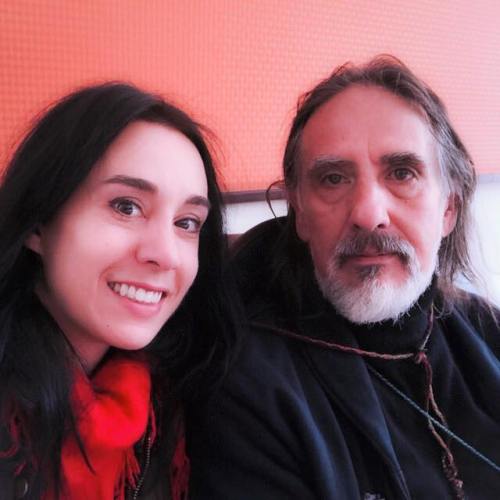by Rich Moreland, July 2016
Olalla is billed as a vampire film, but how do we define vampire in the context it presents? Let’s take a look.
All photos are compliments of Amy Hesketh and Vermeerworks.
* * *
Credit to the Troupe
Robert Louis Stevenson’s original “Olalla” hints at vampirism without any real overt evidence. Keeping this in mind, Amy Hesketh borrows just the right amount from the Victorian short story to expand the narrative without misplacing its thread.
In place of the English officer, she puts a traveler named Roberto (Cristian Del Rio) in the 1800s sequences. Nathan, the family’s guest when the narrative shifts to the present day, is a wartime photojournalist played by Luis Almanza.
Felipe is a dual figure: the younger version is played by Alejandro Loayza A and the older by Jac Avila who is superb as the family’s enforcer.
Lastly, the padre (Rhobess Pierre) serves the same function in both versions of the story.
Other characters are added. There is Olalla’s sister, Ofelia (Mila Joya), the aunt (Maria Esther Arteaga), the “twin” uncles (Beto Lopez L and Fermin Nunez), and the young Olalla and Ofelia (played by sisters Valeria and Rosario Huanca)
Finally, Erix Antoine is terrific as Bruno, the family member who tries his best to keep the house and everyone around him on the edge of normal. Pay close attention to the “muffin verses sweet cake” debate between Bruno and the uncles. The humorous innuendoes are priceless!
Of course, Olalla as mother replaces Stevenson’s character in the filmed version and has daughters who appear as youngsters. They grow up to be the modern Ofelia and Olalla when the narrative moves to the present time.
The film expands on the family as a pack of depraved miscreants. In his story, Stevenson informs the reader that the mother sits in the sun against a pillar and other than brushing her hair, hasn’t “the least spark of energy.” Amy Hesketh’s take on the household presents an indolent aunt and uncles who are robotic without purpose, moving in unison with nowhere to go.
The updated Olalla does change one important element. In a nod to Stevenson’s tale, the mother indeed bites Roberto’s hand, but the impulsive act inflames the villagers and ushers in her death, as we will see.
The Vampire Question
As suggested in the first part of this analysis, the family members are not vampires in the popular sense, but they aren’t vampire-free either. It’s an in-between identity the padre defines as a collection of “strange customs.” Even their dancing at the party is zombie-like, stilted and ludicrous to the point of hilarity.
The family cannot determine their destiny because they are as refrigerated as the bags of blood that await their cocktail hour. They’re in a time warp that repeats itself just as the uncles are aimless and without purpose. How else could two little girls grow into young women and take a century to do it?
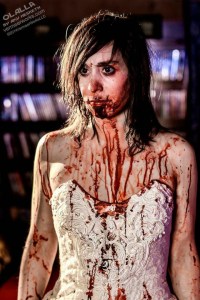 On the other hand, what of Olalla? Does she have a blood fetish, what might be considered clinical vampirism, or is she a killer whose sins her mother paid for in a sadomasochistic show compliments of the Grand Guignol?
On the other hand, what of Olalla? Does she have a blood fetish, what might be considered clinical vampirism, or is she a killer whose sins her mother paid for in a sadomasochistic show compliments of the Grand Guignol?
According to Psychology Today (November 2012), the German physician Richard von Krafft-Ebing established over a century ago the connection between blood and sexuality. He cites a case in which a man allowed his wife to suck the blood from his arm before they had sex. It aroused her apparently.
Of note is that Krafft-Ebing reached this conclusion in the mid-1880s. Perhaps this is the source of Stevenson story, an account of compulsion, erotic energy, and the fear of monsters. If so, the film version of Olalla has its artistic place in literature while exploring human perversion as applicable to the social sciences.
Modern Vampires are Sexier
One more point is significant. If we assume Olalla is a vampire, she hovers between the Nosferatu genre of German Expressionism and Dracula.
Like “Nosferatu” (The Bird of Death), she bites, but her victims simply die and do not become vampires themselves. This is a departure from the Stoker model that Jac Avila uses in Dead But Dreaming.
On the other hand, Nosferatu’s “Count Orlok” is linked to Dracula in one respect.  He vanishes forever when caught in toxic sun light, whereas Dracula is only repelled by it. In either case, it’s a phenomenon that has no effect on Olalla.
He vanishes forever when caught in toxic sun light, whereas Dracula is only repelled by it. In either case, it’s a phenomenon that has no effect on Olalla.
So where does this leave us? Ofelia summarizes the film’s dilemma when she says to Bruno, “Olalla is a danger to all of us.”
Does this mean she is the only real vampire in the family? Or, is the brood afraid her habits will lead to the pitchfork crowd as happened with her mother?
One thing becomes painfully apparent as the film progresses. Olalla commits murder and will do it again.
Later when Ofelia interrupts her sister and Nathan watching Nosfertu, she furthers the vampire question with, “Modern vampires are sexier, don’t you think, Olalla?”
Nathan interjects that he and Olalla like the old version of the undead, whereupon Ofelia declares that those vampires always die “because they’re monsters who can’t control themselves.”
It’s a well-placed jab at her deviant sister.
There we have it. Olalla is like her family, caught in an in-between contradictory state (an “undead” purgatory, perhaps?) that is of the spirits and intangible and centers on evil rather than peace. And, in the end, we really don’t know if they are leftover Stoker sycophants, Count Orlok parasites struggling to survive, or simply blood freaks who are more than a little weird.
Or, perhaps they are a clan of murderers who will symbolically crucify Olalla on her bed to protect themselves . . .
And that is exactly what links Amy Hesketh’s film to the classic enigma of Victorian literature and establishes its credentials for scholarly study.
* * *
By the way, my interpretation of this film is just one point of view. Everyone should check it out for themselves and reach their own conclusions.
In the next post, we’ll examine time as a motif in this film.

